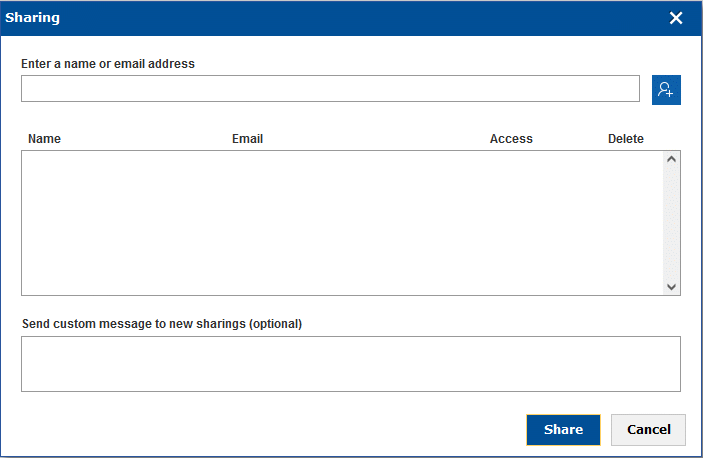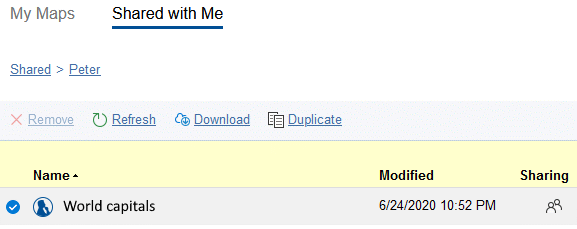You can share files and folders with other users in MindView Online, and they can share files and folders with you. Users can edit shared files simultaneously if they have Read/Write access to the files.
![]() You can also share files and folders with user groups, making it much
quicker to share items with several users at once. You can manage user
groups from the MindView account management page if you are an account
administrator. For more information on your options as an account administrator,
see "Administrator options".
You can also share files and folders with user groups, making it much
quicker to share items with several users at once. You can manage user
groups from the MindView account management page if you are an account
administrator. For more information on your options as an account administrator,
see "Administrator options".
![]() Instead of sharing mind maps with specific
users or user groups in MindView Online, you can publish them online.
By doing so, you make them publicly available and can share them using
e-mail and social media. For more information, see "Publishing
a mind map".
Instead of sharing mind maps with specific
users or user groups in MindView Online, you can publish them online.
By doing so, you make them publicly available and can share them using
e-mail and social media. For more information, see "Publishing
a mind map".
 Do one of the following from the Backstage view:
Do one of the following from the Backstage view:
 Choose
Manage Files, click the three
dots
Choose
Manage Files, click the three
dots ![]() to the right of the
folder or file name that you want to share, and click Share
to the right of the
folder or file name that you want to share, and click Share
![]() .
.
 Share
the currently open mind map (if any) by choosing Share
| Share
Share
the currently open mind map (if any) by choosing Share
| Share ![]() .
.
 In the dialog that opens, do one of the following:
In the dialog that opens, do one of the following:

 Enter the e-mail address of a user, or enter
a user or user group in your MindView account, and press Enter.
Enter the e-mail address of a user, or enter
a user or user group in your MindView account, and press Enter.
![]() You can share files and folders with anyone, but the user will need a
MindView account to access the shared file or folder.
You can share files and folders with anyone, but the user will need a
MindView account to access the shared file or folder.
 Click Add
contact
Click Add
contact ![]() to select a user or user group in your
MindView account from a list. You can filter the list of contacts to show
only users or groups using the drop-down.
to select a user or user group in your
MindView account from a list. You can filter the list of contacts to show
only users or groups using the drop-down.

 (Optional)
Click the Access column
to select an access level.
(Optional)
Click the Access column
to select an access level.
By default, users are given Read/Write access to shared files, but you can change this so that a given user has Read only access.
 (Optional)
Enter a custom message for the users you have just added.
(Optional)
Enter a custom message for the users you have just added.
 Click Share.
Click Share.
When the file or folder is shared, an e-mail is sent to your collaborators (the person or persons you have shared the file or folder with). If you entered a custom message, it is included with the e-mail.
When you have shared a file or
folder with another user or user group, the sharing icon ![]() appears in the Sharing
column in the Manage Files dialog.
appears in the Sharing
column in the Manage Files dialog.
If you have already shared a file or folder with one or more users or user groups, you can update the sharing information as follows:
 Open the sharing dialog by choosing Manage
Files in the Backstage view.
Open the sharing dialog by choosing Manage
Files in the Backstage view.
 Click
the three dots
Click
the three dots ![]() to the right of the folder or file name for which you want to update the
sharing information, and click Share
to the right of the folder or file name for which you want to update the
sharing information, and click Share
![]() .
.
 In the dialog that opens, do one or more of the following:
In the dialog that opens, do one or more of the following:
 Change the access level for the users already
selected.
Change the access level for the users already
selected.
![]() If you change a user's access level from Read/Write access to Read only
access, that user can no longer edit the shared file.
If you change a user's access level from Read/Write access to Read only
access, that user can no longer edit the shared file.
 Select
new users.
Select
new users.
 Remove one or more users by clicking Delete
Remove one or more users by clicking Delete ![]() to stop
sharing the mind map or folder with them.
to stop
sharing the mind map or folder with them.
 Click Share.
Click Share.
![]() Other users can also end the sharing relationship with you if they no
longer wish to have access to the files or folders you have shared with
them. For more information, see "Options
on the Shared with Me tab" in "Managing
files and folders".
Other users can also end the sharing relationship with you if they no
longer wish to have access to the files or folders you have shared with
them. For more information, see "Options
on the Shared with Me tab" in "Managing
files and folders".
When another user has shared a file or folder with you, you receive an e-mail notification directly. The shared files or folders appear on the Shared With Me tab of the Manage Files and Open dialogs and can be opened as normally:

 If
you have Read/Write access to a shared file, you can view, edit, download
and duplicate the file. You can also end the sharing relationship with
the user who shared the file with you; for more information, see "Options
on the Shared with Me tab" in "Managing
files and folders" as well as the topics on editing mind maps
in the "Basic tasks" and "Further tasks" sections.
If
you have Read/Write access to a shared file, you can view, edit, download
and duplicate the file. You can also end the sharing relationship with
the user who shared the file with you; for more information, see "Options
on the Shared with Me tab" in "Managing
files and folders" as well as the topics on editing mind maps
in the "Basic tasks" and "Further tasks" sections.
 If
you have Read only access to a shared file, you can view, download and
duplicate it.
If
you have Read only access to a shared file, you can view, download and
duplicate it.
 You
cannot re-share files or folders that have been shared with you. Only
the creator of the files or folders can share them with other users. Also,
files can only be published by their owner. You can, however, export mind
maps shared with you.
You
cannot re-share files or folders that have been shared with you. Only
the creator of the files or folders can share them with other users. Also,
files can only be published by their owner. You can, however, export mind
maps shared with you.
All users with Read/Write access to a shared file can edit the file, and they can do so simultaneously. All editing features in MindView Online work as normally when several users edit the file at the same time. If another user introduces a change while you are editing the file, the change is saved automatically and shown in the mind map.
Two or more users cannot edit the same item in the mind map simultaneously (for example, editing the same text note or branch label). If this happens, MindView Online keeps the changes introduced by the user who accessed the item first. The other user's changes are discarded. A dialog is shown to inform you if your changes have been discarded.

Example: Users A and B both try to change the formatting of a particular branch. User A accessed the branch first, and therefore her changes are saved. User B's formatting changes are discarded. However, he can edit the branch later if needed when user A has finished editing the branch.
![]() To avoid this kind of situation, try
to arrange for different users to work on different areas of the mind
map.
To avoid this kind of situation, try
to arrange for different users to work on different areas of the mind
map.
As explained in "Exporting to Word", "Exporting to Google Docs", "Exporting to PowerPoint" and "Exporting to PDF", you can export your mind maps. Attached objects in a mind map are not included in the exported document (except for attached pictures which can be included); instead, a link to the attached object is inserted in the exported file.
Anyone may open and edit the exported files. However, to access an attached object using a link and download the object from the original mind map on MindView Online, the user needs to have a MindView account, and you must have shared the mind map with the user.
Example: If user A creates a mind map on MindView Online, shares it with users B and C and then exports it to Word, users B and C can open the exported Word file and access any attached objects in the original mind map by clicking the links in the Word file. If user D opened the Word file, he would not be able to access the attached objects, even though he has a MindView account, as user A has not shared the mind map with him.
![]() Users that you have shared mind maps with can access attached objects
in those mind maps no matter if you gave them Read only or Read/Write
access to the mind map.
Users that you have shared mind maps with can access attached objects
in those mind maps no matter if you gave them Read only or Read/Write
access to the mind map.
As described above, you can export mind maps shared with you. If you do so, the original sharing information of the mind map is kept. In other words, continuing our example above, user B would be able to export the mind map shared with her by user A. However, attached objects in the exported file would still only be accessible to users B and C (the users originally selected for sharing by user A), and user A himself. Only user A would be able to update the sharing information of the mind map; for more information, see "Updating sharing information" above.
If a file or folder was shared with a user group, and the group is deleted, the file or folder is not automatically shared with the individual users who belonged to the now-deleted group.